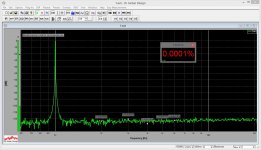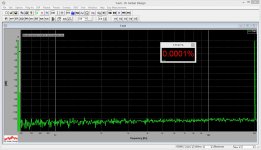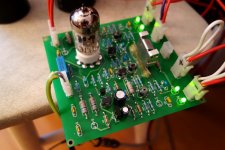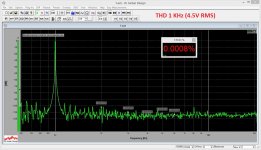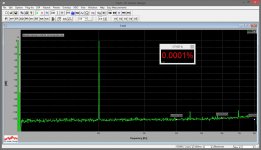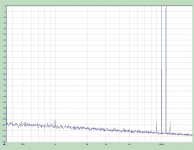anyone?
I don't have neither a ultra low thd sine gen nor a precise thd analyser. I have a very old Terratec soundcard which has a wavetable for sine gen and a 24bit/192 kHz sample Julia soundcard. Any hint, experiences, software very appreciated.
I don't have neither a ultra low thd sine gen nor a precise thd analyser. I have a very old Terratec soundcard which has a wavetable for sine gen and a 24bit/192 kHz sample Julia soundcard. Any hint, experiences, software very appreciated.
Rightmark Audio Analyzer is a popular program for measuring THD. Be warned that a good DIY audio amp will perform better than most soundcards. 🙂
There's nothing poor about the Juli@ soundcard. It's probably still up with current cards and certainly the connector quality and construction are superior to most others. The problem is cost and complexity of presentation quality software. Most is aimed at studio use and good products like ARTA are not so cheap to buy, whatever the number of features. It's still a great, comprehensive combination for a soundcard.
Quantasylum QA 400 USB card package is focused on distortion measurement but cheaper and simpler to install and get results fast: http://www.diyaudio.com/forums/equipment-tools/231401-quantasylum-qa400.html
Unfortunately all souncards lack a suitable wideband precision interface for measuring power amplifiers. You can build one (Member Pete Millet markets a PCB/panel label kit) but there aren't many you can buy simply or cheaply.
Quantasylum QA 400 USB card package is focused on distortion measurement but cheaper and simpler to install and get results fast: http://www.diyaudio.com/forums/equipment-tools/231401-quantasylum-qa400.html
Unfortunately all souncards lack a suitable wideband precision interface for measuring power amplifiers. You can build one (Member Pete Millet markets a PCB/panel label kit) but there aren't many you can buy simply or cheaply.
I think a freeware spectrum analyzer software provided it interfaces to Juli@ drivers would do as an indicative tool, the key to success will be an interface, preferably battery operated, and even more preferably, transformer coupled . But that is already another, say, "dark matter" those audio transformers.
I use the German software from >HERE<, commercial version. With Lynx L22 pro-grade sound card - very precise metering system. External loopback shows THD at the level of 0.0001% at 1KHz as well as at 20KHz (see attached). Output level is 650mV RMS here, sample rate = 192KHz.
Software looks inexpensive comparing to what the Lynx card costs 😛
I love it 😀
Cheers,
Valery
Software looks inexpensive comparing to what the Lynx card costs 😛
I love it 😀
Cheers,
Valery
Attachments
vzaichenko thanx. Lynx is for professionals my objective is just an amp/speaker/listening room system for my own use. Thus the Juli@ card must do - otherwise I could just buy an active monitor speaker e.g. from JBL. I think only very few diy amp plus diy speakers could trump such an active monitor for around 1200 USD a pair.
However I would not trust any sort of a "precision" claim as the interior of a PC is electrically incredibly noisy. The , say, vintage Terratec card targeted at musicians - professional demo recording - came completely metal shielded.
However I would not trust any sort of a "precision" claim as the interior of a PC is electrically incredibly noisy. The , say, vintage Terratec card targeted at musicians - professional demo recording - came completely metal shielded.
Last edited:
I've been using the Behringer UCA202 Audio Interface (USB, so it sits outside the computer) along with the demo version of ARTA software.
ARTA Software
While not perfect, it's quite handy. Main thing it would need to take it to the next level is a precise stepped attenuator on the front end.
I'm sure there are better Audio interfaces, but this one was $30, and has RCA line level I/O, which is about the most useful for what I'm doing.
I'd certainly be happy to hear what other cards and software people are using.
Update My Dynaco
Akitika GT-101 Audio Power Amplifier Kit
ARTA Software
While not perfect, it's quite handy. Main thing it would need to take it to the next level is a precise stepped attenuator on the front end.
I'm sure there are better Audio interfaces, but this one was $30, and has RCA line level I/O, which is about the most useful for what I'm doing.
I'd certainly be happy to hear what other cards and software people are using.
Update My Dynaco
Akitika GT-101 Audio Power Amplifier Kit
... software from >HERE<, commercial version. With Lynx L22 pro-grade sound card - very precise...
Hi Valery
The screen for the 20 kHz THD doesn't show any response past 20 kHz.
If the response is filtered past 20 kHz then the THD will look very impressive, of course😉
Some sound-cards and/or software assume you don't want response past 20 kHz.
Fine for sound but bad for measurement, have you checked this?
Can you show the response past 20 kHz?
Best wishes and compliments of the season (even if it's not orthodox Xmas yet)
David.
Last edited:
Another excellent one (and also cheap nowadays): M-Audio Audiophile 24/96. Use it with the Asio driver, and cPlay software (plays wav and flac files) which bypasses all other paths in the PC used for playing those files, loading the file directly into the RAM of your machine.
Imho, a usually expensive external USB device avoids a lot of noise problems. I can hardly imagine that the high noise level inside a standard PC is not eventually disastrous, i.e. preventing really exact measurement. Even with an external device ( are there any USB 3? don't know) a "signal conditioner", an interface is imho key to success, also, for high quality audio digital recording. I once made one but did only find out, without ground decoupling with transformers, the benefit is limited. Or the effort/ performance ratio is far too high, it should ideally be zero. Thus conclusion these measurement features are in fact indicators. I think should be sufficient for me.
Hi Valery
The screen for the 20 kHz THD doesn't show any response past 20 kHz.
If the response is filtered past 20 kHz then the THD will look very impressive, of course😉
Some sound-cards and/or software assume you don't want response past 20 kHz.
Fine for sound but bad for measurement, have you checked this?
Can you show the response past 20 kHz?
Best wishes and compliments of the season (even if it's not orthodox Xmas yet)
David.
Hi David,
I see what you mean, I had these doubts as well as soon as I started using the software. Unfortunately, it doesn't show anything higher than 22KHz. But it still measures there.
At 192KHz sample rate the sound-card's bandwidth goes up to around 90KHz.
So, for 20KHz signal, the software can see at least the 2-nd, 3-rd and 4-th harmonics, which is good enough.
Measurements for a number of different amps show adequate results.
Attached are the graphs for one of my "serious" hybrid amplifiers, running at 8R load with 3 pairs of IRFP240/9240 at the output.
20KHz THD is 5 times higher than 1KHz one, although we still can't see anything above 20KHz.
I even spoke to Dr Jordan Design engineer - he confirmed, the software measures up to the bandwidth limit (varies according to the sample rate).
Cheers,
Valery
Attachments
Nice IMD measurement. I couldn't get this level of IMD performance from the last soundcard I tried, let alone the amp.
At 192KHz sample rate the sound-card's bandwidth goes up to around 90KHz.
Yes according to sampling theorem. But what about reality? Did you actually measure the frequency response of that sound card? I mean the hard way amplitude-constant sine sweep , save the file in lossless format, play back?
I found for another soundcard the same upper limit of about 28 kHz , for 96 khz and 192 khz sample rate.
?? Manual, page 382Unfortunately, it doesn't show anything higher than 22KHz.
Use Options->Display Properties->Zoom and set x-max to e.g. 42000. You can also double click outside the plot area on the x-axis label an this dialog box opens.
?? Manual, page 382
Hah! BV, thanx a lot 🙂
By some reason, I didn't know about such a simple thing 😛
It works. Here is the same external loop-back spectrum for 20KHz signal.
Some minor artifacts are visible at 45 and 69 KHz, but - c'mon - no complains, excellent performance anyway

Cheers,
Valery
Attachments
Imho, a usually expensive external USB device avoids a lot of noise problems. I can hardly imagine that the high noise level inside a standard PC is not eventually disastrous, i.e. preventing really exact measurement.
I keep hearing this, yet the M-Audio 192 PCI card I've been using is extremely quiet. Measurements of my phono preamp, for an example:
Attachments
Daqarta v7.60 This is quite a handy program as well, with some extras not found in other simular programs.
That points to another issue: these programs appear to interface with the "windows soundcard" that is, the generic windows drivers. Then particular proprietary features of the respective soundcard controlled by associated proprietary drivers are these used, and if so, properly? Dunno...
- Status
- Not open for further replies.
- Home
- Amplifiers
- Solid State
- Experiences with software thd, sine generating
